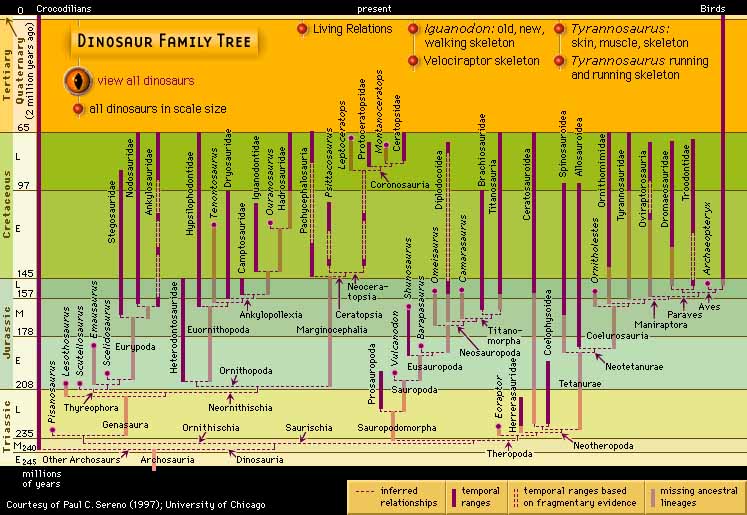

Scale diagram comparing the largest known dinosaurs in five major clades and a human


Scale diagram comparing the largest known dinosaurs in five major clades and a human
Knowledge about dinosaurs is derived from a variety of fossil and non-fossil records, including fossilized bones, feces, trackways, gastroliths, feathers, impressions of skin, internal organs and soft tissues. Many fields of study contribute to our understanding of dinosaurs, including physics (especially biomechanics; dinosaur mass, speed and blood flow), chemistry, biology, and the earth sciences (of which paleontology is a sub-discipline). Two topics of particular interest and study have been dinosaur size and behavior.
Dinosaurs are a diverse group of animals of the clade and superorder Dinosauria. They first appeared during the Triassic period, approximately 230 million years ago, and became the dominant terrestrial vertebrates for 135 million years, from the beginning of the Jurassic (about 200 million years ago) until the end of the Cretaceous (65.5 million years ago), when the Cretaceous-Paleogene extinction event led to the extinction of most dinosaur groups at the close of the Mesozoic era. The fossil record indicates that birds evolved from theropod dinosaurs during the Jurassic, and consequently they are considered a type of dinosaur in modern classification systems. Some birds survived the extinction event that occurred 65 million years ago, and continue the dinosaur lineage to the present day.
Dinosaurs are a varied group of animals from taxonomic, morphological and ecological standpoints. Birds, at over 9,000 living species, are the most diverse group of vertebrates besides perciform fish. Using fossil evidence, paleontologists have identified over 500 distinct genera and more than 1,000 different species of non-avian dinosaurs.
Dinosaurs are represented on every continent by both extant species and fossil remains. Some are herbivorous, others carnivorous. Most dinosaurs have been bipedal, though many extinct groups included quadrupedal species, and some were able to shift between these body postures. Many species possess elaborate display structures such as horns or crests, and some prehistoric groups developed skeletal modifications such as bony armor and spines. Birds have been the planet's dominant flying vertebrate since the extinction of the pterosaurs, and evidence suggests that egg laying and nest building is a trait shared by all dinosaurs.
Many prehistoric dinosaurs were large animals--the largest sauropods could reach lengths of almost 60 meters (200 feet) and were several stories tall--and while many extinct theropods were quite large, a majority evolved very small sizes, especially among birds and other advanced groups.
Although the word dinosaur means "terrible lizard," the name is somewhat misleading, as dinosaurs are not lizards. Rather, they represent a separate group of reptiles with a distinct upright posture not found in lizards. Through the first half of the 20th century, before birds were recognized to be dinosaurs, most of the scientific community believed dinosaurs were sluggish and cold-blooded. Most research conducted since the 1970s, however, has indicated that ancient dinosaurs, particularly the carnivorous groups, were active animals with elevated metabolisms and numerous adaptations for social interaction.
Since the first dinosaur fossils were recognized in the early 19th century, mounted fossil dinosaur skeletons or replicas have been major attractions at museums around the world, and dinosaurs have become a part of world culture. Their diversity, the large sizes of some groups, and their seemingly monstrous and fantastic nature have captured the interest and imagination of the general public for over a century. They have been featured in best-selling books and films such as Jurassic Park, and new discoveries are regularly covered by the media.
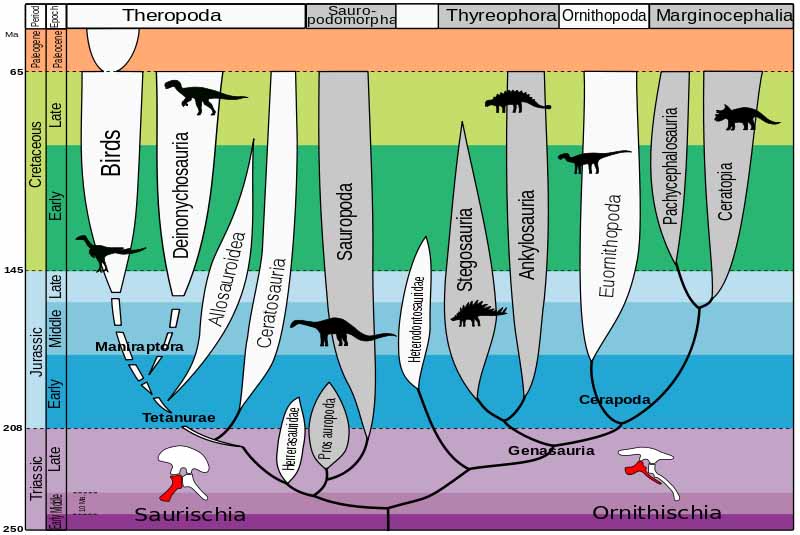
Dinosaurs evolved from a single lineage of archosaurs 232-234 Ma (million years ago) in the Ladinian age, the latter part of the middle Triassic. Dinosauria is a well-supported clade, present in 98% of bootstraps. It is diagnosed by many features including loss of the postfrontal on the skull and an elongate deltopectoral crest on the humerus.
The process leading up to the Dinosauromorpha and the first true dinosaurs can be followed through fossils of the early Archosaurs such as the Proterosuchidae, Erythrosuchidae and Euparkeria which have fossils dating back to 250 Ma, through mid-Triassic archosaurs such as Ticinosuchus 232-236 Ma. Crocodiles are also descendants of mid-Triassic archosaurs.
Dinosaurs can be defined as the last common ancestor of birds (Saurischia) and Triceratops (Ornithischia) and all the descendants of that ancestor. With that definition, the pterosaurs and several species of archosaurs narrowly miss out on being classified as dinosaurs. The pterosaurs are famous for flying through the Mesozoic skies on leathery wings and reaching the largest sizes of any flying animal that ever existed. Archosaur genera that also narrowly miss out on being classified as dinosaurs include Schleromochlus 220-225 Ma, Lagerpeton 230-232 Ma and Marasuchus 230-232 Ma. Read more ...
Dinosaur fossils have been known for millennia, although their true nature was not recognized. The Chinese, whose modern word for dinosaur is konglong ("terrible dragon"), considered them to be dragon bones and documented them as such. For example, Hua Yang Guo Zhi, a book written by Zhang Qu during the Western Jin Dynasty, reported the discovery of dragon bones at Wucheng in Sichuan Province. Villagers in central China have long unearthed fossilized "dragon bones" for use in traditional medicines, a practice that continues today. In Europe, dinosaur fossils were generally believed to be the remains of giants and other creatures killed by the Great Flood.
Scholarly descriptions of what would now be recognized as dinosaur bones first appeared in the late 17th century in England. Part of a bone, now known to have been the femur of a Megalosaurus, was recovered from a limestone quarry at Cornwell near Chipping Norton, Oxfordshire, England, in 1676. The fragment was sent to Robert Plot, Professor of Chemistry at the University of Oxford and first curator of the Ashmolean Museum, who published a description in his Natural History of Oxfordshire in 1677. He correctly identified the bone as the lower extremity of the femur of a large animal, and recognized that it was too large to belong to any known species. He therefore concluded it to be the thigh bone of a giant human similar to those mentioned in the Bible.
In 1699, Edward Lhuyd, a friend of Sir Isaac Newton, was responsible for the first published scientific treatment of what would now be recognized as a dinosaur when he described and named a sauropod tooth, "Rutellum implicatum", that had been found in Caswell, near Witney, Oxfordshire.
Between 1815 and 1824, the Rev William Buckland, a professor of geology at Oxford University, collected more fossilized bones of Megalosaurus and became the first person to describe a dinosaur in a scientific journal.
The second dinosaur genus to be identified, Iguanodon, was discovered in 1822 by Mary Ann Mantell - the wife of English geologist Gideon Mantell. Gideon Mantell recognized similarities between his fossils and the bones of modern iguanas. He published his findings in 1825.
The study of these "great fossil lizards" soon became of great interest to European and American scientists, and in 1842 the English paleontologist Richard Owen coined the term "dinosaur". He recognized that the remains that had been found so far, Iguanodon, Megalosaurus and Hylaeosaurus, shared a number of distinctive features, and so decided to present them as a distinct taxonomic group. With the backing of Prince Albert of Saxe-Coburg-Gotha, the husband of Queen Victoria, Owen established the Natural History Museum in South Kensington, London, to display the national collection of dinosaur fossils and other biological and geological exhibits.
In 1858, the first known American dinosaur was discovered, in marl pits in the small town of Haddonfield, New Jersey (although fossils had been found before, their nature had not been correctly discerned). The creature was named Hadrosaurus foulkii. It was an extremely important find: Hadrosaurus was one of the first nearly complete dinosaur skeletons found (the first was in 1834, in Maidstone, Kent, England), and it was clearly a bipedal creature. This was a revolutionary discovery as, until that point, most scientists had believed dinosaurs walked on four feet, like other lizards. Foulke's discoveries sparked a wave of dinosaur mania in the United States.
Dinosaur mania was exemplified by the fierce rivalry between Edward Drinker Cope and Othniel Charles Marsh, both of whom raced to be the first to find new dinosaurs in what came to be known as the Bone Wars. The feud probably originated when Marsh publicly pointed out that Cope's reconstruction of an Elasmosaurus skeleton was flawed: Cope had inadvertently placed the plesiosaur's head at what should have been the animal's tail end.
The fight between the two scientists lasted for over 30 years, ending in 1897 when Cope died after spending his entire fortune on the dinosaur hunt. Marsh 'won' the contest primarily because he was better funded through a relationship with the US Geological Survey. Unfortunately, many valuable dinosaur specimens were damaged or destroyed due to the pair's rough methods: for example, their diggers often used dynamite to unearth bones (a method modern paleontologists would find appalling).
Despite their unrefined methods, the contributions of Cope and Marsh to paleontology were vast: Marsh unearthed 86 new species of dinosaur and Cope discovered 56, a total of 142 new species. Cope's collection is now at the American Museum of Natural History in New York, while Marsh's is on display at the Peabody Museum of Natural History at Yale University.
After 1897, the search for dinosaur fossils extended to every continent, including Antarctica. The first Antarctic dinosaur to be discovered, the ankylosaurid Antarctopelta oliveroi, was found on Ross Island in 1986, although it was 1994 before an Antarctic species, the theropod Cryolophosaurus ellioti, was formally named and described in a scientific journal.
Current dinosaur "hot spots" include southern South America (especially Argentina) and China. China in particular has produced many exceptional feathered dinosaur specimens due to the unique geology of its dinosaur beds, as well as an ancient arid climate particularly conducive to fossilization. Read more ...

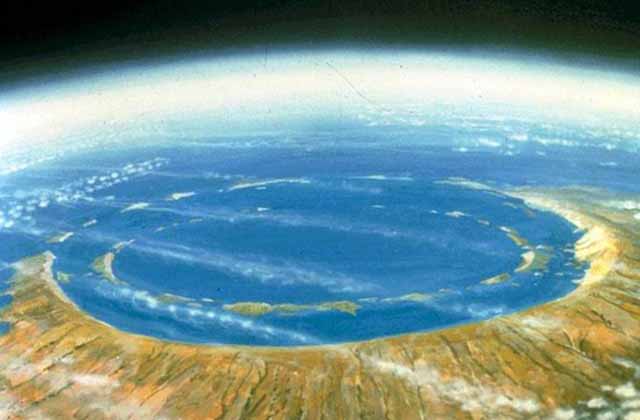
About 65 million years ago at the boundary between the Cretaceous (the last geological period of the Mesozoic) and the Tertiary eras, a large asteroid came rushing out of space at a velocity of more than 25 km per second and impacted the Earth at the tip of the Yucatan platform. It is believed to have caused the extinction of the dinosaurs and other species.
The Chicxulub crater is an impact crater buried underneath the Yucatan Peninsula in Mexico. Its center is offshore, but the crater is named after the onshore community of Chicxulub Pueblo. It was formed slightly over 65 million years ago when a large asteroid, about ten kilometers (six miles) in diameter, struck Earth. The crater is estimated to be 200 kilometers (120 miles) in diameter and 20 kilometers (12 miles) in depth. It is the second largest confirmed impact structure on Earth, and the only one whose peak ring is intact and directly accessible for scientific research.
The date of the impact coincides with the Cretaceous-Paleogene boundary (commonly known as the K-Pg or K-T boundary). It is now widely accepted that the devastation and climate disruption resulting from the impact was the primary cause of the Cretaceous-Paleogene extinction event, a mass extinction of 75% of plant and animal species on Earth, including all non-avian dinosaurs.


Impact crater that killed the dinosaurs may not have been the only one
BBC - August 17, 2022
Was Earth bombarded on that terrible day by more than one space rock? The discovery of what seems to be a second impact crater on the other side of the Atlantic, of a very similar age, is raising these questions. It's not as big as the one we know at Chicxulub in Mexico, but still it speaks to a catastrophic event. Dubbed Nadir Crater, the new feature sits more than 300m below the seabed, some 400km off the coast of Guinea, west Africa.
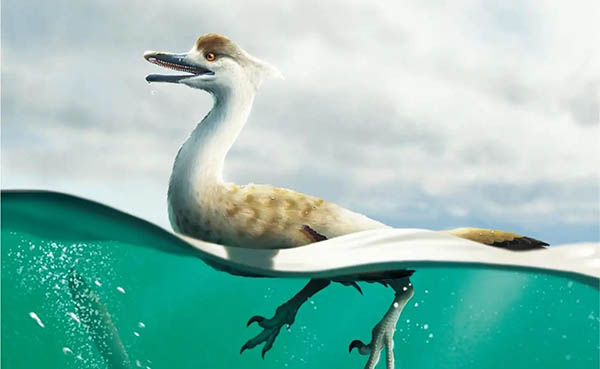
When Dinosaurs Evolved Into Birds
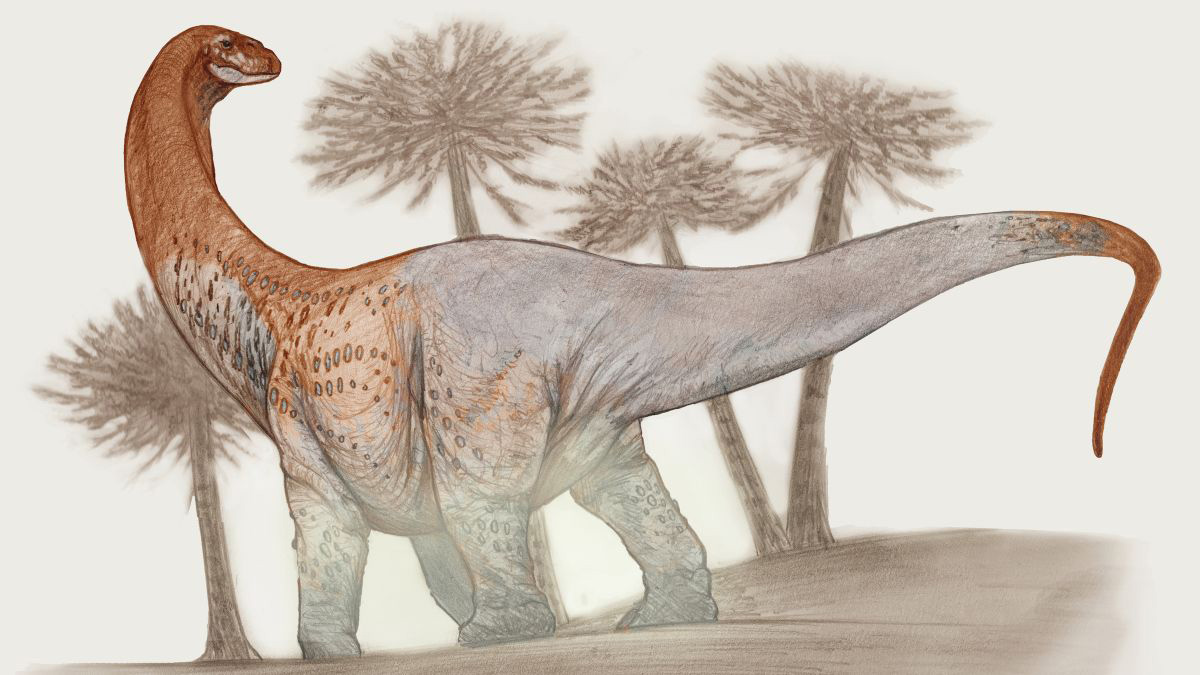
Dinosaurs in the News - Text and Images
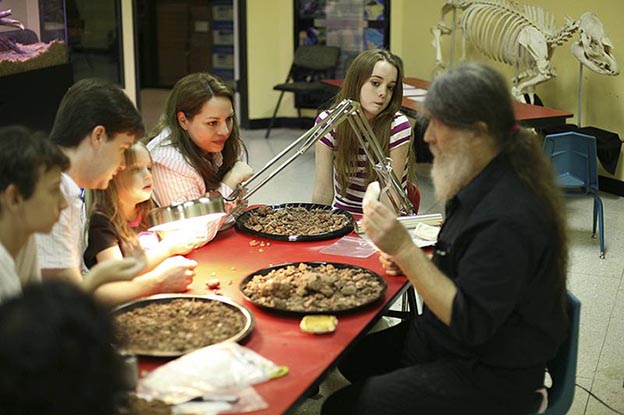
Dinosaur Renaissance was a small-scale scientific revolution that started in the late 1960s, and led to renewed academic and popular interest in dinosaurs. It was sparked by new discoveries and research indicating that dinosaurs may have been active and warm-blooded animals, rather than cold-blooded and sluggish as had been the prevailing view and description during the first half of the twentieth century.
The new view of dinosaurs was championed by John Ostrom, who argued that birds evolved from coelurosaurian dinosaurs, and particularly Robert Bakker who argued passionately that dinosaurs were warm-blooded in a way similar to modern mammals and birds. Bakker frequently portrayed his ideas as a renaissance of those popular in the late nineteenth century, referring to the period in between the wars as "the dinosaur doldrums". The dinosaur renaissance led to a profound shift in thinking on nearly all aspects of dinosaur biology, including physiology, evolution, behavior, ecology and extinction. It has also led to multiple depictions of dinosaurs in popular culture.
The dinosaur renaissance changed not only scientific ideas about dinosaurs, but also their portrayal by artists. Bakker, himself a talented artist, often illustrated his ideas in a lively fashion. Indeed, Bakker's illustration of Deinonychus, made for Ostrom's 1969 description, has become one of the most recognizable and iconic of dinosaur restorations.
During the 1970s, restorations of dinosaurs shifted from being lizard-like, to being more mammal- and bird-like. Artists started to show dinosaurs in more active poses, and incorporating newer theories of dinosaur locomotion and behavior.
Besides Bakker, key artists in this "new wave" were first Mark Hallett, Gregory S. Paul in the 1970s, and during the 1980s Doug Henderson and John Gurche.
Gregory Paul in particular defended and expanded on Bakker's ideas on dinosaur anatomy. He expounded a rigorous and detailed approach to dinosaur restoration, in which he often criticized the errors of the traditionalist approach. He also produced a large number of restorations showing small dinosaurs with feathers, and defended the idea in a number of articles and his book Predatory Dinosaurs of the World. His view was proven largely correct in the late 90s with the discovery of several feathered dinosaurs. Paul's ideas and style have had a significant impact on dinosaur art, and likely will continue to do so for some time.
Traditionally paleontology had followed geology in preferring uniformitarian mechanisms, despite the promotion by Eugene Merle Shoemaker of the importance of catastrophic impacts.
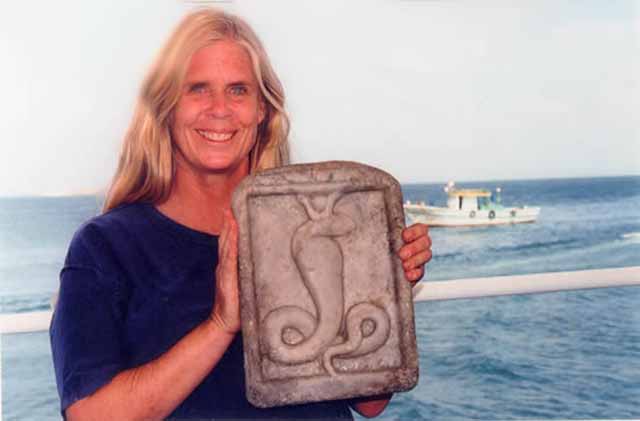
Sue Hendrickson American Paleontologist and Dinosaur Hunter
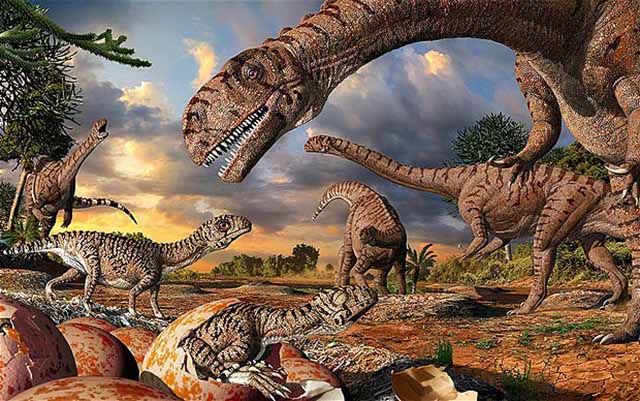
List of Dinosaurs Wikipedia
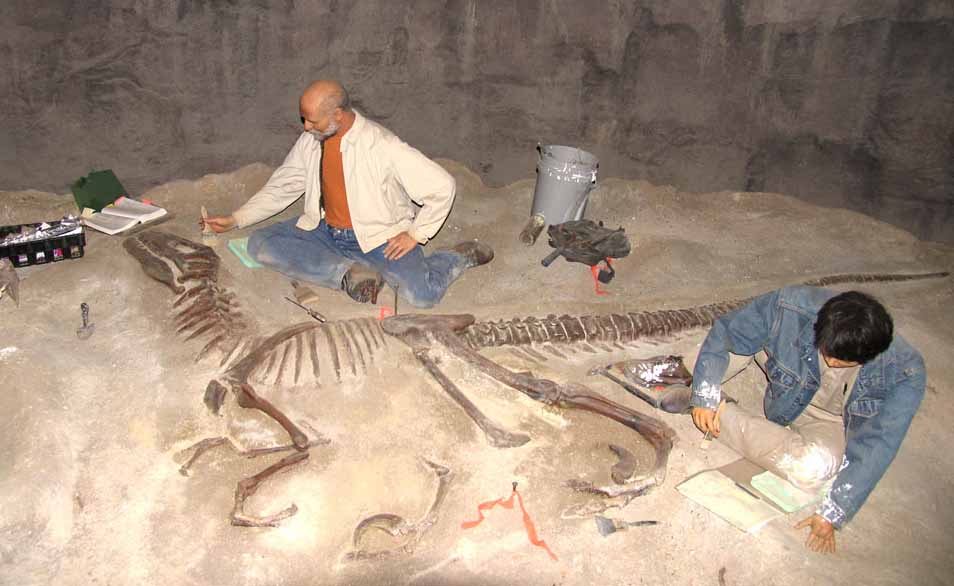
Paleontology Index